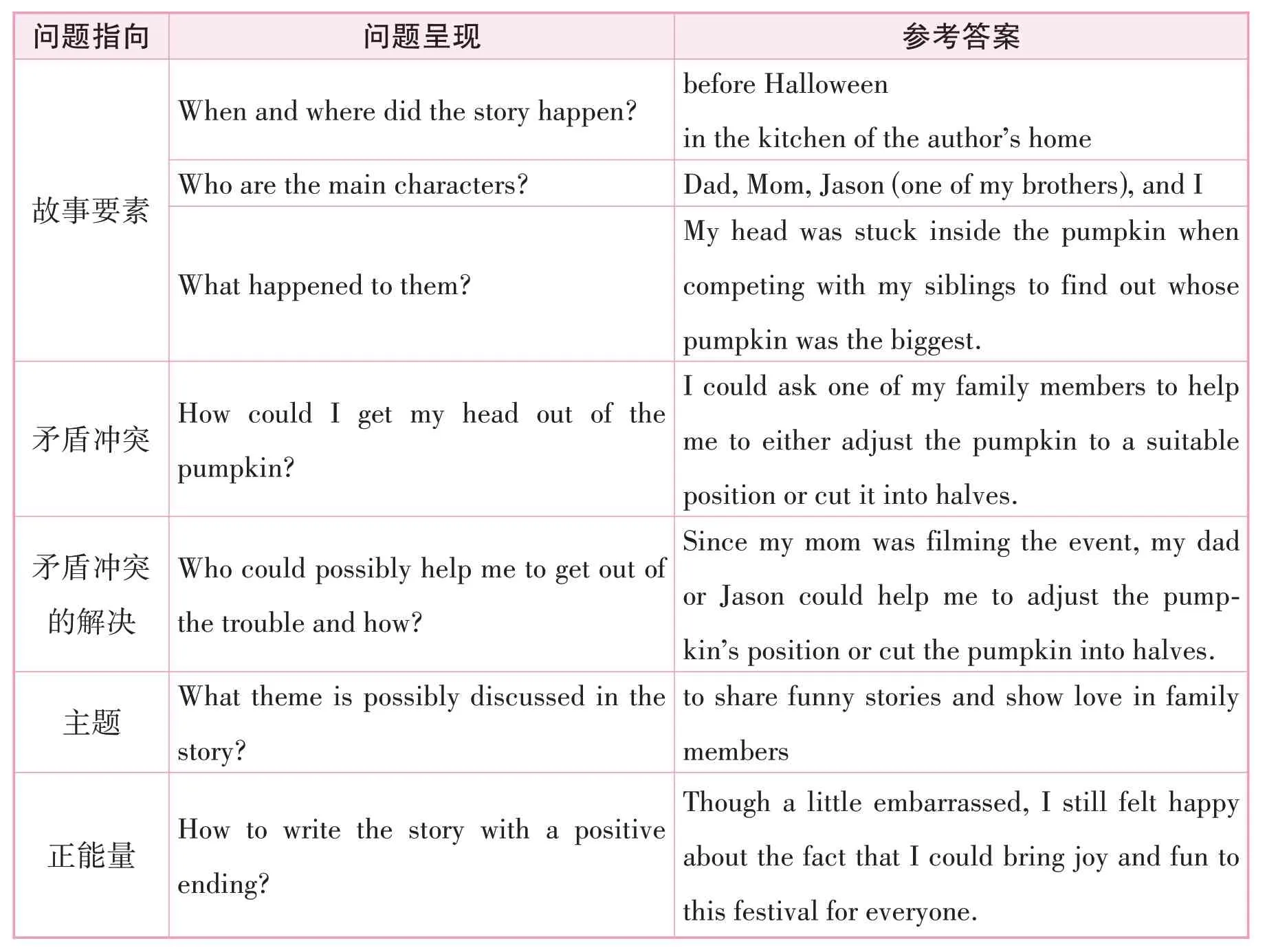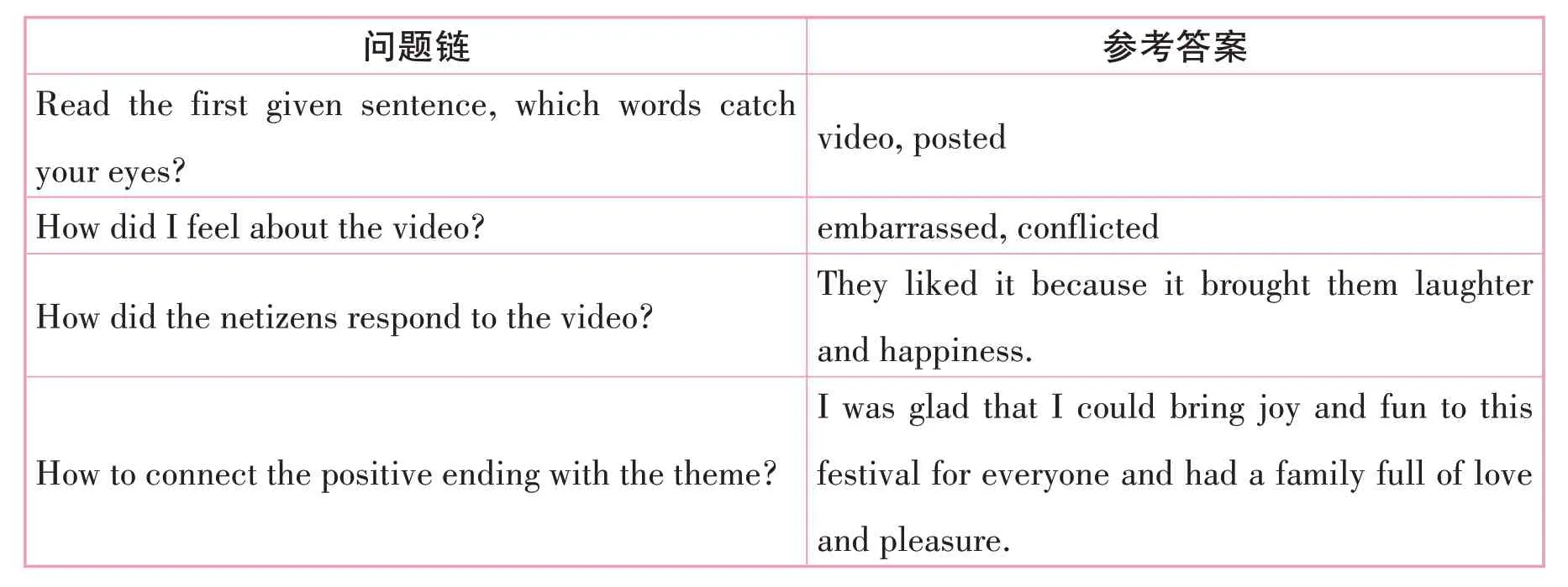问题链预测情节
2024-04-30广东吴娟娟
广东 吴娟娟
【问题导读】

读后续写要求我们依据原文材料的内容和所给段首句进行续写,写出一篇与给定材料有逻辑关系且情节和结构完整的短文。读后续写能否拿高分某种程度上取决于故事情节的构思是否有效,是否合理。续写时,我们常见的问题要么是无话可说,要么是写了不少,但缺乏逻辑或文不对题。以上问题的出现除了学情个体差异等主观因素的影响外,客观因素也对此有影响。一方面,续写内容不是独立存在的,它是已有叙事情节的延续,这就要求我们在主题、情感、人物和事件等方面与已有情节保持一致;另一方面,续写内容主要集中在情节的高潮和结局部分,此部分的故事情节跌宕起伏,节奏多变,故而本身难度大。在读后续写中,通过已知信息搭建问题链支架可以起到穿针引线的作用,不仅能激发我们对故事预测和分析问题的兴趣,还能加强续写情节与原文在语言、情节和情感上的逻辑协同性。
【名师导学】
问题链是指问题与问题之间的精心连接与递进,是教师在教学过程中针对学生现有水平和教学内容提出的一系列层层递进、环环相扣的串联式问题。续写问题链是围绕原文和所给段首句设置的一系列由浅入深的追问,从而形成严密而有节奏的“读—思—问”过程。设置环环相扣的续写问题链,首先需要深度解读原文,再厘清故事脉络,把握故事内涵,提炼文本主题后仔细解读所给两个段首句,循序渐进地指向情节发展主线。基于此,问题的设置应遵循以下原则:
1.问题指向故事要素
我们在阅读原文后,借助引导性问题提取记叙文的基本要素,梳理文本,为预测情节提供背景依据。常见的设问方式:
Q1: When and where did the story happen?
Q2: Who are the main characters and what kind of persons are they?
2.问题指向矛盾冲突
叙事类文体的故事通常围绕矛盾冲突和问题解决来展开,因此矛盾冲突在语篇中尤为重要。提出指向矛盾冲突的问题,找出外部矛盾和内在冲突,才能抓住故事的情节发展主线。常见的设问方式:
Q3: What happened to them in the story?
Q4: Why would the character make such a decision?
3.问题指向矛盾冲突的解决
矛盾冲突的解决是引领故事情节发展的主要环节。我们可以通过预设结局,结合所给伏笔,采用倒推法追问矛盾冲突的解决方法与措施,预测情节的发展、高潮与结局。常见的设问方式:
Q5: How to write the story with a positive ending?
Q6: What would the main characters do or what they have done to meet up with the ending?
4.问题指向主题和正能量
文章的主题是续写的风向标,决定着故事的发展方向。正能量结尾是学科育人价值的体现。把握住这两点才能确保续写情节在逻辑和思想上与原文保持一致。常见的设问方式:
Q7: What are the positive aspects mentioned in the story?
Q8: What theme is possibly discussed in the story?
5.问题指向首句
基于所给两个段首句,我们在提取关键信息后,设置有关行为、情感和结果等能引领故事发展的问题,预测情节。续写第一段的内容往往是故事的高潮,我们需要利用段首句合理推测相关人物解决问题的具体方式和实施过程。在把握好续写方向并明确核心冲突的解决方法后,我们可以分别根据两个段首句的信息进行步步紧跟、环环相扣的追问,推理出合理的故事情节。常见的设问方式:
Q9: Read the first given sentence,which words catch your eyes?
Q10: What would the character say/do?
Q11: How did the character feel?
Q12: How would the others respond to the character's action?
Q13: What was the result?
【案例导引】
阅读下面材料,根据其内容和所给段落开头语续写两段,使之构成一篇完整的短文。
(2021 年1 月浙江卷)Pumpkin carving at Halloween is a family tradition.We visit a local farm every October.In the pumpkin field,I compete with my three brothers and sister to seek out the biggest pumpkin.My dad has a rule that we have to carry our pumpkins back home,and as the eldest child I have an advantage—I carried an 85-pounder back last year.
This year,it was hard to tell whether my prize or the one chosen by my 14-year-old brother,Jason,was the winner.Unfortunately we forgot to weigh them before taking out their insides,but I was determined to prove my point.All of us were hard at work at the kitchen table,with my mom filming the annual event.I'm unsure now why I thought forcing my head inside the pumpkin would settle the matter,but it seemed to make perfect sense at the time.
With the pumpkin resting on the table,hole uppermost,I bent over and pressed my head against the opening.At first I got jammed just above my eyes and then,as I went on with my task,unwilling to quit,my nose briefly prevented entry.Finally I managed to put my whole head into it,like a cork (软木塞) forced into a bottle.I was able to straighten up with the huge pumpkin resting on my shoulders.
My excitement was short-lived.The pumpkin was heavy.“I'm going to set it down,now,” I said,and with Jason helping to support its weight,I bent back over the table to give it somewhere to rest.It was only when I tried to remove my head that I realized getting out was going to be less straightforward than getting in.When I pulled hard,my nose got in the way.I got into a panic as I pressed firmly against the table and moved my head around trying to find the right angle,but it was no use.“I can't get it out!” I shouted,my voice sounding unnaturally loud in the enclosed space.
注意:续写词数应为150左右。
Paragraph 1:
I was stuck for five or six minutes though it felt much longer._______________________________________________________________________________________________________________
Paragraph 2:
That video was posted the day before Halloween.________________________________________________________________________________________________________________________
文本解读
一、原文问题链
“我”为了与兄弟姐妹比谁的南瓜更大,居然把头伸进已取出瓤的南瓜里,结果头被卡在里面,后来在家人的帮助下“我”终于脱险。这个过程也被妈妈拍成视频发到网上,这件事成为“我”一次难忘的经历。

二、首句问题链
Paragraph 1: I was stuck for five or six minutes though it felt much longer.

Paragraph 2: That video was posted the day before Halloween.

参考范文
Paragraph 1:
I was stuck for five or six minutes though it felt much longer.Inside was full of my anxious breath.How I wished I had not acted so foolishly! Noticing my repeated efforts but in vain,Jason darted out of the kitchen and turned to Dad for help.Seeing me trapped in such an awkward situation,Dad was unexpectedly surprised at first,but soon surprise transformed into laughter.He tried many approaches,and eventually managed to get my head out by carefully cutting the pumpkin open with a knife.Just when I felt relieved to be freed from the pumpkin,I suddenly found that Mom had been filming everything.
Paragraph 2:
The video was posted the day before Halloween.Never had I felt so embarrassed but never had I ever been so famous.Instantly,without a few hours,the video went viral.My emotions were so conflicted between whether I should be happy or sad.But then I saw some comments from netizens saying that the video had lifted their mood and brought them much laughter.Their words brought warmth to my heart and it was then that I could let my embarrassment go.Now I felt lucky that I could add joy and fun to this festival for everyone and have a family full of love and pleasure.
【模拟导练】
阅读下面材料,根据其内容和所给段落开头语续写两段,使之构成一篇完整的短文。
(2022年新高考Ⅰ卷)It was the day of the big cross-country run.Students from seven different primary schools in and around the small town were warming up and walking the route (路线) through thick evergreen forest.
I looked around and finally spotted David,who was standing by himself off to the side by a fence.He was small for ten years old.His usual big toothy smile was absent today.I walked over and asked him why he wasn't with the other children.He hesitated and then said he had decided not to run.
What was wrong? He had worked so hard for this event!
I quickly searched the crowd for the school's coach and asked him what had happened.“I was afraid that kids from other schools would laugh at him,” he explained uncomfortably.“I gave him the choice to run or not,and let him decide.”
I bit back my frustration (懊 恼).I knew the coach meant well—he thought he was doing the right thing.After making sure that David could run if he wanted,I turned to find him coming towards me,his small body rocking from side to side as he swung his feet forward.
David had a brain disease which prevented him from walking or running like other children,but at school his classmates thought of him as a regular kid.He always participated to the best of his ability in whatever they were doing.That was why none of the children thought it unusual that David had decided to join the cross-country team.It just took him longer—that's all.David had not missed a single practice,and although he always finished his run long after the other children,he did always finish.As a special education teacher at the school,I was familiar with the challenges David faced and was proud of his strong determination.
注意:续写词数应为150左右。
Paragraph 1:
We sat down next to each other,but David wouldn't look at me.________________________________________________________________________________________________________________________________________________________________________________________________________________________________________________
Paragraph 2:
I watched as David moved up to the starting line with the other runners.________________________________________________________________________________________________________________________________________________________________________________________________________________________________________________
【评价导思】
1.我续写的内容是否紧扣文章主题?我又是如何回应主题的?
_________________________________________________________________________________________
_________________________________________________________________________________________
2.续写这篇文章的时候,我提出了哪些能推动情节发展和丰富故事节奏的问题?我是如何提炼这些问题的?
_________________________________________________________________________________________
_________________________________________________________________________________________
3.在结尾处,我运用了哪种方式呼应开头并凸显主题意义?
_________________________________________________________________________________________
_________________________________________________________________________________________
